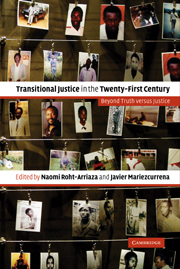The new landscape of transitional justice
Published online by Cambridge University Press: 05 June 2012
Summary
Darfur, Guantánamo, Iraq, Haiti. As this book goes to press, they are the headlines, today's sites of killing and mistreatment of civilians and torture of prisoners. Abuses during conflict are not new. Nor is the demand, in many parts of the world, that something be done in their aftermath, that there be justice. But there is a growing sense that something can and must be done, not only to stop the atrocities but also to bring those responsible to account, to make the facts known, and to succor the victims. The Security Council refers the situation in Darfur to the International Criminal Court. In 2005, Spanish courts sentence an Argentine naval officer to 640 years in a Spanish jail for throwing prisoners, alive but drugged, from airplanes into the sea a quarter-century before. Slowly, often after years have passed and sometimes in venues far from the scene of the crimes, demands for justice emerge. The past, unaccounted for, does not lie quiet.
The study of how societies emerging from periods of civil war or dictatorship deal with the legacies of the past became a full-fledged subject of academic inquiry and human rights activism during the 1990s. The term itself is a bit slippery: transitional justice can be defined as the “conception of justice associated with periods of political change, characterized by legal responses to confront the wrongdoings of repressive predecessor regimes.”
- Type
- Chapter
- Information
- Transitional Justice in the Twenty-First CenturyBeyond Truth versus Justice, pp. 1 - 16Publisher: Cambridge University PressPrint publication year: 2006
- 48
- Cited by

